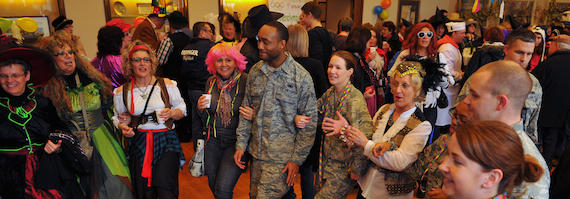The FRG. The Family Readiness Group. These three words can conjure up so many images. Some are good, some not so much. So you can imagine the feelings that came up for me when I was asked to lead my husband’s unit FRG.
I immediately started thinking of my own experiences volunteering with different FRG’s and what that was like. Then it hit me-- it was going to be up to ME to get this party started, to learn how to start a FRG.
So, I did what many brave men and women before me have done when faced with adversity. I went on Facebook and put out a call for help to all of my friends.
The responses were varied. I got many versions of “horror stories” that befell several FRG’s. I heard about challenges I would face and the small triumphs I would treasure.
The great part was that not ANY of my friends discouraged me. They all rolled up their virtual sleeves and offered their advice. So I will share their sage advice with you. Ladies and Gentlemen who are tasked to start or restart or uplift an FRG, here are the top tips:
Top 10: How to Start a FRG
1. Training, training and much more training.
Be trained in all things FRG. One useful website: Myarmyonesource.com. They have online FRG Leader trainings on all things FRG. You do have to sign up (find the button at the upper right hand corner), but at the end you are given a certificate proving you did it all. ACS – Army Community Services is also a valuable resource. They offer more trainings and resources than you could ever need. Get it.
2. It takes a team.
In the world of FRG, we have our unit commander, the Family Readiness Liaison and the Family Readiness Support Assistant or FRSA. This is your leadership team. They will provide you with direction, mission, information, resources, paperwork and support. Then there are your teammates, the ones who do the work with you, your fellow volunteers. Every member of your team is vital to the success of your FRG. Use them, and use them well.
3. Clear mission and plan.
Most of this comes from the trainings and your command. It’s important to remember that you should meet with command regularly to discuss how to meet the needs of your unit’s service members and families. One of the main missions for most FRG’s is to be a source of information and relaying of information between command and families. Phone Trees will become a big part of your job, as preparing for deployments and trainings need a solid communication structure. Other primary responsibilities should be making sure that families know about the resources available to them in an emergency, during deployment, and day to day for morale, personal and professional development.
4.Know the law.
You have to know the law. You don't have to be like JAG or NCIS, but know what your FRG can and can’t do. This is where SOP’s come in (Standard Operating Procedures). Read them and know them. There are rules about fundraising, what goes in a newsletter; even issues like whether or not you can hold a bake sale.
The best piece of advice: before you get too in the weeds with getting your FRG set up and planning events get very, VERY familiar with the regulations governing FRG.
5. The “Family” in Family Readiness Group is not what you think.
The “family” in Family Readiness Group can be anyone that the service member feels they want involved and knowledgeable about happenings within their unit. A “family” member could be a spouse and children, just a spouse, just children, adult children, parents, grandparents, siblings, girlfriends, boyfriends, fiancés, friends, civilians that work with the unit, veterans and others connected to the group.
6. Pass on your knowledge and use the knowledge that came before.
FRG’s often (but don’t always) have something called a “continuity book.” It’s like the owner’s manual for the FRG. In it you can find all of the wisdom of previous FRG Leaders. What worked. What didn’t work. SOP’s, important forms, contacts, resources, everything that could be useful might be in that book.
And like Yoda, you too will pass down your knowledge to the next FRG leader. If you don’t have a continuity book, create one. It makes the job that much easier and smoothes transitions.
7. Think outside the box.
Because of regulations and the fact that you could have family members hundreds if not thousands of miles away, it becomes important that you “think outside the box.” For those far away you can offer online coffee chat times (through google hangouts) for example.
In order to connect better with service members and families create an FRG business card so you are more easily accessible. Use social media like I did to get advice or to join groups where others can impart their wisdom.
8. Delegate responsibility.
Don't go it alone. Start reaching out right away for folks to take up the other leadership roles. Once you have your team, don’t be afraid to tell people exactly what you need from them, and when. If you delegate responsibility and are clear about expectations you are less likely to encounter problems.
9. Have fun.
Don’t forget the social aspects of the FRG. You have opportunities to bring families together for some fun – be creative with holiday parties and summer picnics. If your events are fun more families will participate.
10. Take care of yourself.
It's easy to lose yourself in this job. Don't forget that while you are there to support the families, YOUR family and YOU need to be your #1 focus. If you feel yourself getting burned out, ask for help or step back from activities. Take the time to recharge.
Remember it’s like your grandmother said, if you don’t take care of yourself you can’t take care of others. Truer words were never spoken.
Time to add your two cents:
I'm not done collecting tips on how to run an FRG. If you have learned some things you would like to pass along to the SpouseBuzz audience, all of us would appreciate your tips, too!
Ingrid Herrera-Yee is a military spouse, a clinical and research psychologist and the AFI 2014 National Guard Spouse of the Year. She is the Founder of an organization for Military Spouse Behavioral Health clinicians (msbhc.org) and resides in Maryland with her husband and three beautiful boys.
U.S. Air Force photo by Airman 1st Class Dillon Davis










